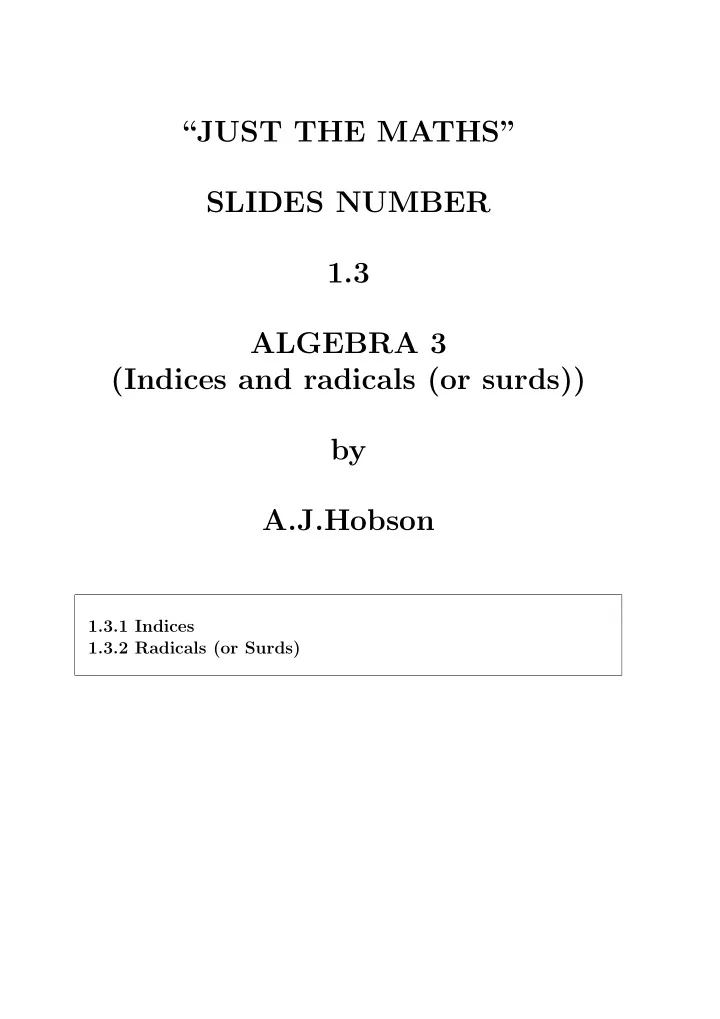

“JUST THE MATHS” SLIDES NUMBER 1.3 ALGEBRA 3 (Indices and radicals (or surds)) by A.J.Hobson 1.3.1 Indices 1.3.2 Radicals (or Surds)
UNIT 1.3 - ALGEBRA 3 INDICES AND RADICALS (or Surds) 1.3.1 INDICES (a) Positive Integer Indices Let a and b be arbitrary numbers Let m and n be natural numbers Law No. 1 a m × a n = a m + n Law No. 2 a m ÷ a n = a m − n assuming m greater than n . Note: a m = a m − m = a 0 . a m a m = 1 and a m Hence, we define a 0 to be equal to 1. Law No. 3 ( a m ) n = a mn a m b m = ( ab ) m 1
EXAMPLE Simplify the expression, x 2 y 3 ÷ xy z 5 . z Solution The expression becomes x 2 y 3 × z 5 xy = xy 2 z 4 . z (b) Negative Integer Indices Law No. 4 a − 1 = 1 a Note: a and a m − [ m +1] = a − 1 . a m a m +1 = 1 Law No. 5 a − n = 1 a n Note: a n and a m − [ m + n ] = a − n a m a m + n = 1 2
Law No. 6 a −∞ = 0 EXAMPLE Simplify the expression, x 5 y 2 z − 3 x − 1 y 4 z 5 ÷ z 2 x 2 y − 1 . Solution The expression becomes x 5 y 2 z − 3 xy − 4 z − 5 y − 1 z − 2 x − 2 = x 4 y − 3 z − 10 . (c) Rational Indices (i) Indices of the form 1 n where n is a natural number. 1 n means a number which gives a when it is raised to the a power n . It is called an “ n -th Root of a ” and, sometimes there is more than one value. ILLUSTRATION 1 1 4 = ± 3 but ( − 27) 3 = − 3 only 81 3
(ii) Indices of the form m n where m and n are natural numbers with no common factor. m 1 1 n = ( y m ) n or ( y n ) m . y ILLUSTRATION 3 = 3 2 = 9 or 27 2 2 1 3 = 729 3 = 9 27 Note: It may be shown that all of the standard laws of indices may be used for fractional indices. 1.3.2 RADICALS (or Surds) “ √ ” denotes the positive or principal square root of a number. √ √ eg. 16 = 4 and 25 = 5. The number under the radical is called the RADICAND The principal n-th root of a number a is n √ a n is the index of the radical. ILLUSTRATIONS 1. 3 √ 64 = 4 since 4 3 = 64 2. 3 √− 64 = − 4 since ( − 4) 3 = − 64 4
3. 4 √ 81 = 3 since 3 4 = 81 4. 5 √ 32 = 2 since 2 5 = 32 5. 5 √− 32 = − 2 since ( − 2) 5 = − 32 Note: If the index of the radical is an even number, then the radicand may not be negative. (d) Rules for Square Roots (i) ( √ a ) 2 = a √ a 2 = | a | (ii) √ √ ab = √ a (iii) b √ a � a (iv) b = √ b assuming that all the radicals can be evaluated ILLUSTRATIONS 1. √ 9 × 4 = √ √ √ 36 = 6 and 9 × 4 = 3 × 2 = 6 √ √ � 144 144 36 = 12 2. 36 = 4 = 2 and 6 = 2. √ 5
(e) Rationalisation of Radical (or Surd) Expressions. EXAMPLES 5 1. Rationalise the surd form √ 4 3 Solution √ √ 5 5 3 = 5 3 3 √ √ √ 3 = 3 × 4 4 12 3 √ a 2. Rationalise the surd form 3 √ b Solution 3 √ 3 √ 3 √ 3 √ a 3 √ a b 2 ab 2 ab 2 3 √ 3 √ 3 √ 3 √ b = b × b 2 = b 3 = b 4 3. Rationalise the surd form √ √ 5+ 2 Solution √ √ We use ( √ a + b )( √ a − b ) = a − b √ √ √ √ 4 5 − 2 2 = 4 5 − 4 2 √ √ √ √ 2 × 3 5 + 5 − 1 4. Rationalise the surd form √ 3 − 1 Solution √ √ 1 3 + 1 3 + 1 √ √ 3 − 1 × 3 + 1 = 2 6
(f) Changing numbers to and from radical form n | = n √ m | a a m EXAMPLES 2 5 in radical form 1. Express the number x Solution Answer = 5 √ x 2 2. Express the number 3 √ a 5 b 4 in exponential form Solution 3 √ 1 5 4 a 5 b 4 = ( a 5 b 4 ) 3 = a 3 b 3 7
Recommend
More recommend